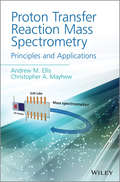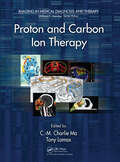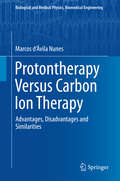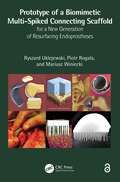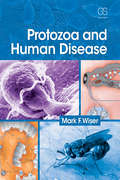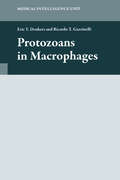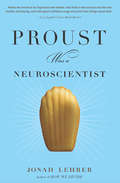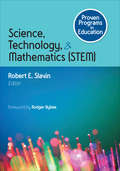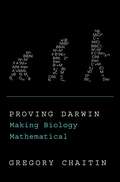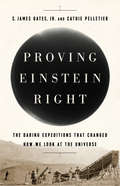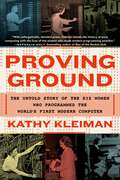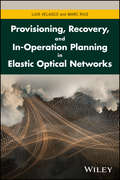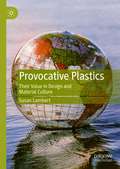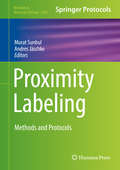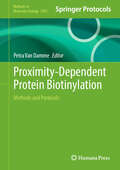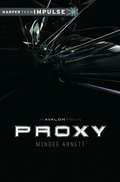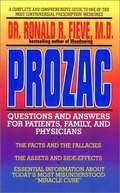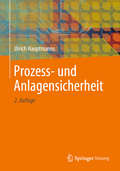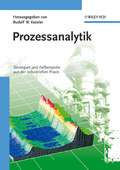- Table View
- List View
Proton Transfer Reaction Mass Spectrometry
by Andrew M. Ellis Christopher A. MayhewProton Transfer Reaction Mass Spectrometry (PTR-MS) is a rapidly growing analytical technique for detecting and identifying very small quantities of chemical compounds in air. It has seen widespread use in atmospheric monitoring and food science and shows increasing promise in applications such as industrial process monitoring, medical science and in crime and security scenarios. Written by leading researchers, this is the first book devoted to PTR-MS and it provides a comprehensive account of the basic principles, the experimental technique and various applications, thus making this book essential reading for researchers, technicians, postgraduate students and professionals in industry.The book contains nine chapters and is divided into two parts. The first part describes the underlying principles of the PTR-MS technique, including * the relevant ion-molecule chemistry* thermodynamics and reaction kinetics * a discussion of ion sources, drift tubes and mass spectrometers* practical aspects of PTR-MS, including calibration.The second part of the book turns its attention to some of the many applications of PTR-MS, demonstrating the scope and benefits, as well as the limitations, of the technique. The chapters that make up the second part of the book build upon the material presented in the first part and are essentially self-contained reviews focusing on the following topics:* environmental science * food science* medicine * homeland security, and * applications of PTR-MS in liquid analysis.
Proton and Carbon Ion Therapy (Imaging in Medical Diagnosis and Therapy)
by C.-M. Charlie Ma Tony LomaxProton and Carbon Ion Therapy is an up-to-date guide to using proton and carbon ion therapy in modern cancer treatment. The book covers the physics and radiobiology basics of proton and ion beams, dosimetry methods and radiation measurements, and treatment delivery systems. It gives practical guidance on patient setup, target localization, and trea
Protontherapy Versus Carbon Ion Therapy
by Marcos D'Ávila NunesThis book presents a comparison analysis of two cancer treatment therapies: carbon ion therapy and protontherapy. It is divided in 5 sections. The first ones gives the reader a brief history of Radiotherapy and types of radiation. In the second section, the techniques and equipments, including new ones in development such as Cyclinac , Laser and DWA, are described. The third section describes biophysical (such as stopping power and LET) and biological (such as RBE and OER) properties, the fundamental experiments and clinical area. The fourth section presents models and the fifth section compares both techniques, showing advantages and disadvantages of each, and their similarities.
Protoplast Technology: Methods and Protocols (Methods in Molecular Biology #2464)
by Kan Wang Feng ZhangThis detailed volume collects protocols from scientists who are actively engaged in developing or using protoplast technology. The book begins with chapters that focus on basic protoplast techniques and their utilities, such as protocols on protoplast isolation, transfection, and regeneration, as well as examples of how to use protoplasts for genome editing and gene function analysis in a number of major crop or model plant species. It continues by exploring protoplast automation, large scale functional genomics, and synthetic biology. Written for the highly successful Methods in Molecular Biology series, chapters include introductions to their respective topics, lists of the necessary materials and reagents, step-by-step, readily reproducible laboratory protocols, and tips on troubleshooting and avoiding known pitfalls. Authoritative and practical, Protoplast Technology: Methods and Protocols aims to inspire the new generation of researchers to further improve their protocols and apply this technology to accelerate the field of plant genomic study.
Prototype of a Biomimetic Multi-Spiked Connecting Scaffold for a New Generation of Resurfacing Endoprostheses
by Ryszard Uklejewski Piotr Rogala Mariusz WinieckiThe monograph comprehensively presents the research on the prototype of the biomimetic Multi-Spiked Connecting Scaffold (MSC-Scaffold) for cementless fixation of the components of a new generation of resurfacing arthroplasty (RA) endoprostheses. This research, carried out by a bioengineering-surgical team from three Polish universities, includes bioengineering design, rapid prototyping, manufacturing in selective laser melting, functionalization, surface modification, numerical studies, experimental in vitro studies, and pilot surgical experiments in an animal model. Features: Presents the prototype of the multi-spiked connecting scaffold for a new generation of resurfacing endoprostheses of the knee and the hip Explains this prototype scaffold as the first worldwide design of the biomimetic fixation of components of diarthrodial joints resurfacing endoprostheses Insights into the entire process of bioengineering design and research on this novel way of resurfacing endoprostheses fixation Reviews main results of the scaffold prototyping and SLM manufacturing, structural and osteoconductive functionalization, and surface modification Reports experimental and numerical investigations of mechanical behavior of the scaffold-bone system, cell culture studies, and pilot surgical experiments in animal models This book is aimed at professionals and graduate students in biomedical engineering, biomaterials engineering, and bone & joint surgery. The Open Access version of this book, available at http://www.taylorfrancis.com, has been made available under a Creative Commons [Attribution-Non Commercial-No Derivatives (CC-BY-NC-ND)] 4.0 license.
Protozoa and Human Disease
by Mark F WiserProtozoa and Human Disease is a textbook on medically important protozoa and the diseases they cause for advanced undergraduate students, graduate students, and professionals. It combines a taxonomic and medical approach and is therefore suitable for a parasitology, microbiology, medical, and public health readership. In addition to the basics such as morphological features, life cycles, and the clinical manifestations of the diseases, topics like the molecular and immunological basis of pathogenesis, metabolic pathways, specialized subcellular structures, ecology of disease transmission, antigenic variation, and molecular epidemiology are discussed for many of the protozoan pathogens. At the end of the book is an extensive glos
Protozoans in Macrophages
by Eric Denkers Ricardo T. GazzinelliUsing as a theme the encounter between protozoan parasites and macrophages, this volume brings together cell biologists, immunologists and protozoologists to review current developments in this broad and dynamic research area. Discussed are ways protozoans establish their intracellular niche, how they activate macrophage effector functions, what th
Protyposis – eine Einführung: Bewusstsein und Materie aus Quanteninformation (essentials)
by Thomas GörnitzDas vorliegende essential stellt die Protyposis als abstrakte bedeutungsoffene Qubits (AQIs) vor. Dies sind die physikalisch und mathematisch einfachsten Quantenstrukturen. Deren fundamentale Rolle begründet eine durchgängige Erklärung der kosmischen Entwicklung, der Herausformung materieller Teilchen, von Leben und Bewusstsein. Aus ihr folgen Strukturen der Wechselwirkungen, der gravitativen, elektromagnetischen, schwachen und starken. In einem Lebewesen werden AQIs für dieses auch zu bedeutungsvoller Information. Die AQIs formen Körper und Psyche als „Uniware“ zu einer Einheit, die ein hochentwickeltes Bewusstsein zu freien Entscheidungen befähigt. Es agiert sowohl logisch als auch spontan, im Gegensatz zur KI sogar nicht-algorithmisch.
Proust Was a Neuroscientist
by Jonah LehrerThe New York Times–bestselling author provides an &“entertaining&” look at how artists enlighten us about the workings of the brain (New York magazine). In this book, the author of How We Decide and Imagine: How Creativity Works &“writes skillfully and coherently about both art and science&”—and about the connections between the two (Entertainment Weekly). In this technology-driven age, it&’s tempting to believe that science can solve every mystery. After all, it&’s cured countless diseases and sent humans into space. But as Jonah Lehrer explains, science is not the only path to knowledge. In fact, when it comes to understanding the brain, art got there first. Taking a group of artists—a painter, a poet, a chef, a composer, and a handful of novelists—Lehrer shows how each one discovered an essential truth about the mind that science is only now rediscovering. We learn, for example, how Proust first revealed the fallibility of memory; how George Eliot discovered the brain&’s malleability; how the French chef Escoffier discovered umami (the fifth taste); how Cézanne worked out the subtleties of vision; and how Gertrude Stein exposed the deep structure of language—a full half-century before the work of Noam Chomsky and other linguists. More broadly, Lehrer shows that there&’s a cost to reducing everything to atoms and acronyms and genes. Measurement is not the same as understanding, and art knows this better than science does. An ingenious blend of biography, criticism, and first-rate science writing, Proust Was a Neuroscientist urges science and art to listen more closely to each other, for willing minds can combine the best of both to brilliant effect. &“His book marks the arrival of an important new thinker . . . Wise and fresh.&” —Los Angeles Times
Proust and the Squid: The Story and Science of the Reading Brain
by Maryanne WolfMany scholars believe that humans are hard-wired for language, but no one, points out Wolf (child development, Tufts U.), believes that about reading and writing. The act of reading is not natural, she argues, either for a child or in the evolution of the brain's capacity to learn. She loves it anyway, and here shares her knowledge and joy at learning to read in both evolutionary and development contexts; she also explores reasons that some people cannot learn to read. By the way, Proust says they were just friends; the squid is not commenting.
Proust and the Squid: The Story and Science of the Reading Brain
by Maryanne Wolf"Human beings were never born to read," writes Tufts University cognitive neuroscientist and child development expert Maryanne Wolf. <P><P>Reading is a human invention that reflects how the brain rearranges itself to learn something new. <P><P>In this ambitious, provocative book, Wolf chronicles the remarkable journey of the reading brain not only over the past five thousand years, since writing began, but also over the course of a single child's life, showing in the process why children with dyslexia have reading difficulties and singular gifts. <P><P>Lively, erudite, and rich with examples, Proust and the Squid asserts that the brain that examined the tiny clay tablets of the Sumerians was a very different brain from the one that is immersed in today's technology-driven literacy. <P><P>The potential transformations in this changed reading brain, Wolf argues, have profound implications for every child and for the intellectual development of our species.
Proven Programs in Education: Science, Technology, and Mathematics (STEM)
by Robert E. SlavinLet the best evidence based practices guide you to STEM success. This series turns research into practice with practical, evidence-based advice from the world’s premier education researchers and authors. In this volume, top articles on science, technology, and math provide multiple perspectives on current STEM issues as well as strategies for effective teaching of STEM subjects at all grade levels. Each chapter offers: Research and case studies showcasing innovative approaches to teaching Best practices, validated by research, that have stood the test of time Practical advice you can put to work right away Sources for additional exploration of the research
Proven Programs in Education: Science, Technology, and Mathematics (STEM)
by Robert E. SlavinLet the best evidence based practices guide you to STEM success. This series turns research into practice with practical, evidence-based advice from the world’s premier education researchers and authors. In this volume, top articles on science, technology, and math provide multiple perspectives on current STEM issues as well as strategies for effective teaching of STEM subjects at all grade levels. Each chapter offers: Research and case studies showcasing innovative approaches to teaching Best practices, validated by research, that have stood the test of time Practical advice you can put to work right away Sources for additional exploration of the research
Proving Darwin: Making Biology Mathematical
by Gregory ChaitinGroundbreaking mathematician Gregory Chaitin gives us the first book to posit that we can prove how Darwin's theory of evolution works on a mathematical level. For years it has been received wisdom among most scientists that, just as Darwin claimed, all of the Earth's life-forms evolved by blind chance. But does Darwin's theory function on a purely mathematical level? Has there been enough time for evolution to produce the remarkable biological diversity we see around us? It's a question no one has yet answered--in fact, no one has even attempted to answer it until now. In this illuminating and provocative book, Gregory Chaitin argues that we can't be sure evolution makes sense without a mathematical theory. He elucidates the mathematical scheme he's developed that can explain life itself, and examines the works of mathematical pioneers John von Neumann and Alan Turing through the lens of biology. Chaitin presents an accessible introduction to metabiology, a new way of thinking about biological science that highlights the mathematical structures underpinning the biological world. Fascinating and thought-provoking, Proving Darwin makes clear how biology may have found its greatest ally in mathematics.
Proving Einstein Right: The Daring Expeditions that Changed How We Look at the Universe
by Cathie Pelletier S. James Gates,A thrilling adventure story chronicling the perilous journey of the scientists who set out to prove the theory of relativity--the results of which catapulted Albert Einstein to fame and forever changed our understanding of the universe.In 1911, a relatively unknown physicist named Albert Einstein published his preliminary theory of gravity. But it hadn't been tested. To do that, he needed a photograph of starlight as it passed the sun during a total solar eclipse. So began a nearly decade-long quest by seven determined astronomers from observatories in four countries, who traveled the world during five eclipses to capture the elusive sight. Over the years, they faced thunderstorms, the ravages of a world war, lost equipment, and local superstitions. Finally, in May of 1919, British expeditions to northern Brazil and the island of Príncipe managed to photograph the stars, confirming Einstein's theory.At its heart, this is a story of frustration, faith, and ultimate victory--and of the scientists whose efforts helped build the framework for the big bang theory, catapulted Einstein to international fame, and shook the foundation of physics.
Proving Ground: The Untold Story of the Six Women Who Programmed the World’s First Modern Computer
by Kathy KleimanDiscover a fascinating look into the lives of six historic trailblazers in this World War II-era story of the American women who programmed the world's first modern computer. After the end of World War II, the race for technological supremacy sped on. Top-secret research into ballistics and computing, begun during the war to aid those on the front lines, continued across the United States as engineers and programmers rushed to complete their confidential assignments. Among them were six pioneering women, tasked with figuring out how to program the world's first general-purpose, programmable, all-electronic computer—better known as the ENIAC—even though there were no instruction codes or programming languages in existence. While most students of computer history are aware of this innovative machine, the great contributions of the women who programmed it were never told—until now. Over the course of a decade, Kathy Kleiman met with four of the original six ENIAC Programmers and recorded extensive interviews with the women about their work. Proving Ground restores these women to their rightful place as technological revolutionaries. As the tech world continues to struggle with gender imbalance and its far-reaching consequences, the story of the ENIAC Programmers' groundbreaking work is more urgently necessary than ever before, and Proving Ground is the celebration they deserve.
Provisional Bibliography of Atlases, Floras and Faunas of European Cities: 1600-2014
by John G. KelceyThe bibliography provides information about the presence and distribution of plants and animals in cities throughout Europe. It will be of considerable interest to and should be used by a wide range of people including academics, researchers, librarians, school teachers, and people with a general interest in the natural history of cities. The bibliography is an important tool for the professions involved in the planning, design and management of high quality urban developments, including biologists, architects, urban designers, planners, consultants, medics. , sociologists, engineers, politicians, landscape architects, building surveyors, agronomists and landscape managers.
Provisioning, Recovery, and In-Operation Planning in Elastic Optical Networks
by Luis Velasco Marc RuizExplains the importance of Elastic Optical Networks (EONs) and how they can be implemented by the world’s carriers This book discusses Elastic Optical Networks (EONs) from an operational perspective. It presents algorithms that are suitable for real-time operation and includes experimental results to further demonstrate the feasibility of the approaches discussed. It covers practical issues such as provisioning, protection, and defragmentation. It also presents provisioning and recovery in single layer elastic optical networks (EON). The authors review algorithms for provisioning point-to-point, anycast, and multicast connections, as well as transfer-based connections for datacenter interconnection. They also include algorithms for recovery connections from failures in the optical layer and in-operation planning algorithms for EONs. Provisioning, Recovery and In-operation Planning in Elastic Optical Network also examines multi-layer scenarios. It covers virtual network topology reconfiguration and multi-layer recovery, and includes provisioning customer virtual networks and the use of data analytics in order to bring cognition to the network. In addition, the book: Presents managing connections dynamically—and the flexibility to adapt the connection bitrate to the traffic needs fit well for new types of services, such as datacenter interconnection and Network Function Virtualization (NFV) Examines the topic in a holistic and comprehensive way, addressing control and management plane issues for provisioning, recovery, and in-operation planning Covers provisioning, recovery, and in-operation planning for EONs at the proposed exhaustive level The rapid expanse of new services has made the use of EONs (a relatively new concept) a necessity. That’s why this book is perfect for students and researchers in the field of technologies for optical networks (specifically EONs), including network architectures and planning, dynamic connection provisioning, on-line network re-optimization, and control and management planes. It is also an important text for engineers and practitioners working for telecom network operators, service providers, and vendors that require knowledge on a rapidly evolving topic.
Provocative Plastics: Their Value in Design and Material Culture
by Susan LambertPlastics have now been our most used materials for over fifty years. This book adopts a new approach, exploring plastics’ contribution from two perspectives: as a medium for making and their value in societal use. The first approach examines the multivalent nature of plastics materiality and their impact on creativity through the work of artists, designers and manufacturers. The second perspective explores attitudes to plastics and the different value systems applied to them through current research undertaken by design, materials and socio-cultural historians. The book addresses the environmental impact of plastics and elucidates the ways in which they can and must be part of the solution. The individual viewpoints are provocative and controversial but together they present a balanced and scholarly un-picking of the debate that surrounds this ubiquitous group of materials. The book is essential reading for a wide academic readership interested in the Arts and Humanities, especially Design and Design History; Anthropology; and Cultural, Material and Social Histories.
Proximity Labeling: Methods and Protocols (Methods in Molecular Biology #2008)
by Murat Sunbul Andres JäschkeThis book provides detailed protocols and untold tips and tricks regarding the most well-known examples of proximity labeling methods, in which the protein of interest is genetically fused to or labeled with an enzyme that can generate short-lived reactive species to non-specifically label molecules within a certain radius of up to twenty nanometers. Beginning with peroxidase-based proximity labeling methods, the volume continues with BioID, proximity labeling methods that describe the proximity ligation assay to detect RNA-DNA interactions, UV cross-linking to demonstrate RNA-protein interactions, and how chemical and enzymatic reactivities can be improved upon DNA-DNA and protein-protein interactions, as well as “proximity-induced self-labeling,” where the radius of labeling is zero. Written for the highly successful Methods in Molecular Biology series, chapters include introductions to their respective topics, lists of the necessary materials and reagents, step-by-step, readily reproducible laboratory protocols, and tips on troubleshooting and avoiding known pitfalls. Authoritative and practical, Proximity Labeling: Methods and Protocols serves as an ideal guide for researchers exploring the crucial roles that proximity-driven reactions play in biological systems.
Proximity-Dependent Protein Biotinylation: Methods and Protocols (Methods in Molecular Biology #2953)
by Petra Van DammeThis volume explores the cutting-edge of proximity-dependent protein biotinylation approaches, focusing on innovative biotin ligase (BioID) and peroxidase-based methods, like APEX. Spanning a diverse array of biological systems, including bacteria, zebrafish, plants, and mammals, this collection showcases methods that aid in the identification of protein interactions, localization, membrane topology, trafficking, and secretion dynamics. Additionally, the book features applications at the host/microbe interface and for the use of tissue-specific biotinylation for studying interorgan communication, as well as in silico validation methods. Written for the highly successful Methods in Molecular Biology series, chapters include introductions to their respective topics, detailed lists of the necessary materials and reagents, step-by-step and readily reproducible laboratory protocols, and expert tips for troubleshooting and avoiding known pitfalls. Authoritative and practical, Proximity-Dependent Protein Biotinylation: Methods and Protocols serves as an essential guide for researchers advancing the study of proxeome biology.
Proxy: An Avalon Novella
by Mindee ArnettProxy is an action-packed introduction to a world like nothing readers have seen before, and it sets a spark to the powder keg that will explode in Mindee Arnett's sci-fi thriller Avalon.If you need something stolen from any star system in the Confederation, you need look no further than the Shades. Jeth Seagrave and his band of teenage mercenaries have been making a name for themselves for being able to steal anything--and for disappearing before anyone is the wiser. Their latest job, a jewel heist on Grakkus, should be no different. But when Jeth's boss replaces a key member of his crew just before takeoff, and Jeth discovers a betrayal within his own ranks, he begins to suspect that not everyone is going to be coming back from his job alive.HarperTeen Impulse is a digital imprint focused on young adult short stories and novellas, with new releases the first Tuesday of each month.
Prozac: Questions and Answers
by Ronald R. FieveFeatured on the cover of "Newsweek" and "New York Magazine. ". . debated on television and radio, written about in daily newspapers, "Prozac has raised hopes and sparked controversies across the country. But how much do you really know about "Prozac, the alleged "miracle drug" that doctors worldwide have employed to help alleviate crippling clinical depression in their patients?The bestselling author of "Moodswing," Dr. Ronald R. Fieve is one of the nation's foremost experts on "Prozac and its uses. In a clear, concise and easy-to-use format, he provides detailed and authoritative answers to the most commonly asked questions about "Prozac. . . giving essential information to help make "informed" decisions on this complex, often confusing, prescription, and offering interpretation of the effects of "Prozac on personality as well as the dangers of prescribing "Prozac to "misdiagnosed" patients.
Prozess- und Anlagensicherheit
by Ulrich HauptmannsStörfälle in technischen Anlagen sind Zufallsereignisse. Deshalb kann man sie nicht gänzlich vermeiden. Wohl aber lassen sich die Wahrscheinlichkeit ihres Auftretens und das Schadensausmaß verringern. In diesem Buch werden, ausgehend von Gefährdungen durch Stoffe und Betriebsbedingungen, mögliche technische und organisatorische Maßnahmen aufgezeigt, Gefährdungen zu mindern. Qualitative Analysemethoden zum Auffinden von Schwachstellen und zur Erhöhung der Sicherheit sowie Modelle zur Abschätzung von Störfallfolgen werden dargestellt. Die quantitative Bewertung der Wirksamkeit von Maßnahmen zur Verbesserung von Anlagentechnik und Sicherheit wird erläutert. Dabei spielen Unsicherheiten, die aus dem Zufallscharakter des Störfalls und aus Kenntnislücken bei einigen der zu behandelnden Phänomene folgen, eine Rolle. Der Leser wird mit Methoden der Störfallsimulation sowie Sicherheits- und Risikoanalysen vertraut gemacht und lernt, Möglichkeiten und Grenzen mathematischer Modellierung einzuschätzen. Als Grundlage sicherheitsrelevanter Entscheidungen wird die Risikoermittlung u.a. auf die Beurteilung der „funktionalen Sicherheit“ und die Bestimmung „angemessener Sicherheitsabstände“ zwischen Industrie und Bebauung angewandt. Zahlreiche ausgearbeitete Beispiele und Fallstudien realer Anlagen und Situationen vertiefen die Inhalte und erleichtern das Selbststudium.Die zweite Auflage des vorliegenden Buches eröffnete die Möglichkeit, den Text gründlich durchzusehen und eine Reihe von Korrekturen vorzunehmen. Zusätzliche Beispiele, die sich aus Anfragen aus der Praxis ergaben, wurden aufgenommen. Das Kapitel über „angemessene Sicherheitsabstände“ wurde um aktuelle Erfahrungen aus der Beratertätigkeit des Verfassers erweitert.
Prozessanalytik: Strategien und Fallbeispiele aus der industriellen Praxis
by Rudolf W. Kessler Herausgegeben VonIn den letzten Jahren hat sich der Trend zu einer hoheren Komplexitat in der Fertigung industrieller Guter verstarkt. Optische und spektroskopische Methoden zur Prozessanalytik sind sehr schnell, messen beruhrungslos und damit zerstorungsfrei. Mit geringem Aufwand wird so eine hundertprozentige Kontrolle bei der Qualitatsprufung moglich. Kernpunkt einer neuen Strategie ist der Einsatz von analytischen Online-Methoden als Qualitatskontrolle sowie die Kombination dieser Techniken mit den Methoden der Datenanalyse zur Steuerung von Produktionsprozessen. Das Buch liefert sowohl einen Uberblick uber die industriell bedeutenden Analyseverfahren als auch praktische Beispiele zur Einfuhrung der Online-Analytik in den industriellen Alltag. Damit wird die gesamte Prozess- und Fertigungsindustrie angesprochen - von der chemischen, pharmazeutischen, biotechnologischen und verfahrenstechnischen Industrie bis zur Kunststoff-, Automobil- und der klassischen Fertigungsindustrie. Nach einer Lehre als Chemielaborant, einem Chemie-Ingenieurstudium an der Fachhochschule Reutlingen und einem Chemiestudium an der Universitat in Tubingen hat Rudolf W. Kessler 1980 am Institut fur Physikalische Chemie in Tubingen promoviert. Seine berufliche Laufbahn fuhrte ihn uber die Forschung bei Daimler Benz 1985 an die Fachhochschule Reutlingen. Als Grundungsdirektor des Institutes fur Angewandte Forschung 1990 und dessen Leiter bis zum Jahr 2000 war er ma?geblich am Aufbau der Prozessanalytik in Forschung und Lehre der Hochschule Reutlingen beteiligt. Zahlreiche nationale und viele internationale Projekte, sowie Forschungsaufenthalte in China, USA, England und vor kurzem auch wieder ein Jahr in der Industrie haben den Praxisbezug der Lehre und der Forschung auf dem Gebiet der optischen Online-Spektroskopie hergestellt. Seit einigen Jahren beschaftigt sich Rudolf W. Kessler auch mit der Nahfeldspektroskopie und dem "Chemical Imaging" von Werkstoffen und Oberflachen.
